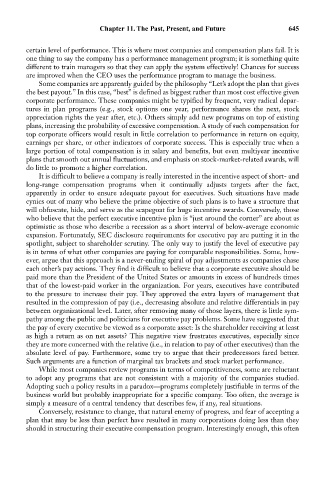Page 660 - Bruce Ellig - The Complete Guide to Executive Compensation (2007)
P. 660
Chapter 11. The Past, Present, and Future 645
certain level of performance. This is where most companies and compensation plans fail. It is
one thing to say the company has a performance management program; it is something quite
different to train managers so that they can apply the system effectively! Chances for success
are improved when the CEO uses the performance program to manage the business.
Some companies are apparently guided by the philosophy “Let’s adopt the plan that gives
the best payout.” In this case, “best” is defined as biggest rather than most cost effective given
corporate performance. These companies might be typified by frequent, very radical depar-
tures in plan programs (e.g., stock options one year, performance shares the next, stock
appreciation rights the year after, etc.). Others simply add new programs on top of existing
plans, increasing the probability of excessive compensation. A study of such compensation for
top corporate officers would result in little correlation to performance in return on equity,
earnings per share, or other indicators of corporate success. This is especially true when a
large portion of total compensation is in salary and benefits, but even multiyear incentive
plans that smooth out annual fluctuations, and emphasis on stock-market-related awards, will
do little to promote a higher correlation.
It is difficult to believe a company is really interested in the incentive aspect of short- and
long-range compensation programs when it continually adjusts targets after the fact,
apparently in order to ensure adequate payout for executives. Such situations have made
cynics out of many who believe the prime objective of such plans is to have a structure that
will obfuscate, hide, and serve as the scapegoat for huge incentive awards. Conversely, those
who believe that the perfect executive incentive plan is “just around the corner” are about as
optimistic as those who describe a recession as a short interval of below-average economic
expansion. Fortunately, SEC disclosure requirements for executive pay are putting it in the
spotlight, subject to shareholder scrutiny. The only way to justify the level of executive pay
is in terms of what other companies are paying for comparable responsibilities. Some, how-
ever, argue that this approach is a never-ending spiral of pay adjustments as companies chase
each other’s pay actions. They find it difficult to believe that a corporate executive should be
paid more than the President of the United States or amounts in excess of hundreds times
that of the lowest-paid worker in the organization. For years, executives have contributed
to the pressure to increase their pay. They approved the extra layers of management that
resulted in the compression of pay (i.e., decresasing absolute and relative differentials in pay
between organizational level. Later, after removing many of those layers, there is little sym-
pathy among the public and politicians for executive pay problems. Some have suggested that
the pay of every executive be viewed as a corporate asset: Is the shareholder receiving at least
as high a return as on net assets? This negative view frustrates executives, especially since
they are more concerned with the relative (i.e., in relation to pay of other executives) than the
absolute level of pay. Furthermore, some try to argue that their predecessors fared better.
Such arguments are a function of marginal tax brackets and stock market performance.
While most companies review programs in terms of competitiveness, some are reluctant
to adopt any programs that are not consistent with a majority of the companies studied.
Adopting such a policy results in a paradox—programs completely justifiable in terms of the
business world but probably inappropriate for a specific company. Too often, the average is
simply a measure of a central tendency that describes few, if any, real situations.
Conversely, resistance to change, that natural enemy of progress, and fear of accepting a
plan that may be less than perfect have resulted in many corporations doing less than they
should in structuring their executive compensation program. Interestingly enough, this often

